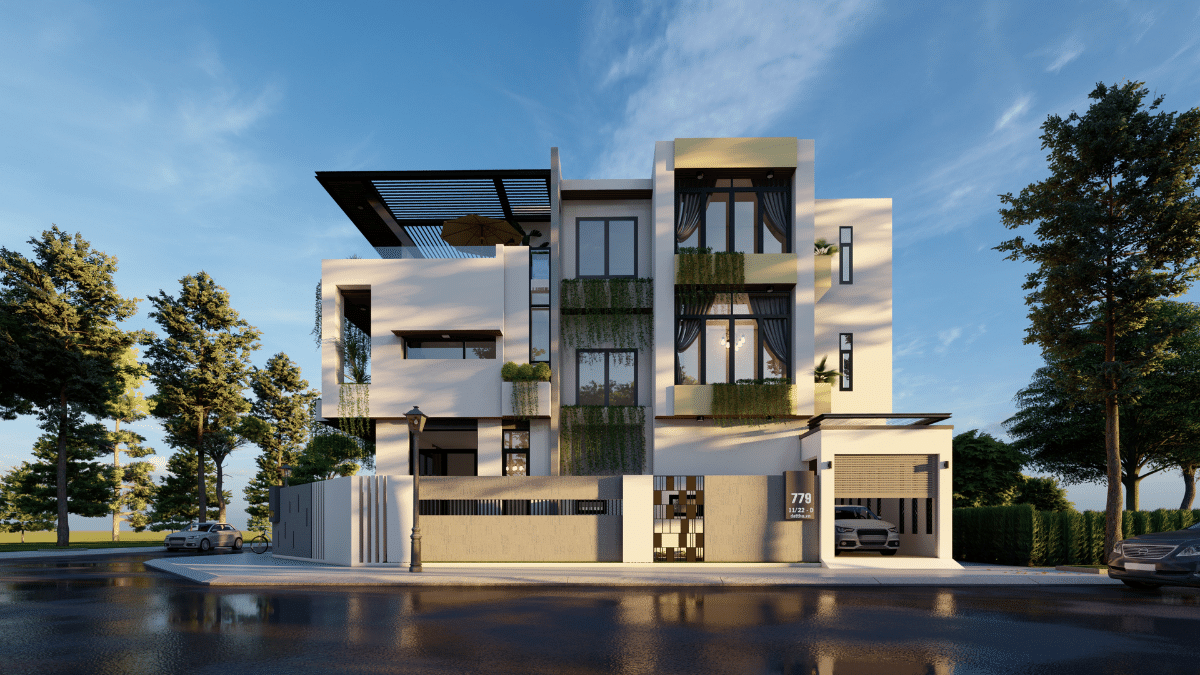Constructing a home is a dream for many, but it comes with a host of challenges, such as obtaining permits, adhering to the rules and regulations set by state development authorities, and undergoing inspections. Among these, understanding the bye-laws can be particularly daunting since they vary from state to state, and the complex PDF documents can be overwhelming for most homeowners. However, we simplify these tedious and confusing processes to help you achieve your dream home. If you plan to build your home in Haryana, we present to you the easy-to-understand version of the Haryana Building Bye-Laws for 2021.
Ground Coverage in Haryana
In simpler terms, Ground Coverage refers to the area occupied by the building on the ground level. This includes spaces like shafts, lifts, stairs, and atriums. However, certain areas like a ventilation shaft larger than 3 square meters, fire staircases, and open courtyards of a permissible size are not included in the calculation. Recently, the Haryana Building Code-2017 has been amended to allow 85% coverage for small plots ranging from 60 to 150 square meters. For plots between 150 and 225 square meters, house owners can cover up to 70% of the area as ground coverage.
Floor Area Ratio (FAR) in Haryana
FAR, or Floor Area Ratio, is a measurement of the total floor area of a building on all floors, compared to the total area of the site it is built on. This ratio determines the extent of construction that can be carried out on a given plot. The formula to calculate the FAR is straightforward: it is the total covered area of all floors, multiplied by 100, and then divided by the plot area. By using this formula, one can easily determine the FAR of a plot, and understand the amount of construction that is permissible on it.
Below is the permissible coverage for FAR as per the Town and Country Planning Department, Haryana:
| Plot Size / Category | Maximum Permissible Coverage for each floor | FAR | ||
| Existing | Additional | Total | ||
| Upto 75sqm | 66 | 1.65 | 0.99 | 2.64 |
| Above 75 & upto 100sqm | 66 | 1.65 | 0.99 | 2.64 |
Above 100 & upto 150sqm | 66 | 1.45 | 1.19 | 2.64 |
Above 150 & upto 200sqm | 66 | 1.45 | 1.19 | 2.64 |
| Above 200 & upto 250sqm | 66 | 1.45 | 1.19 | 2.64 |
Above 250 & upto 350sqm | 60 | 1.25 | 1.15 | 2.40 |
Above 350 & upto 500sqm | 60 | 1.20 | 1.20 | 2.40 |
| Above 500sqm | 60 | 1.00 | 1.40 | 2.40 |
Setbacks in Haryana
Setbacks refer to the minimum open space that must be maintained around a building or structure, as determined by the state’s development authority. The setback distance is the amount of space required between the building and the boundaries of the plot, and it must be maintained on all sides of the building. The Haryana Building Code outlines the minimum setback requirements, which are as follows:
| Sr. No. | Area of plot (in square metres) | Minimum Front Setback (in metres) | Minimum Rear Setback (in metres) |
| 1. | Upto 60 square metres | 0.5 | 0.5 |
| 2. | Above 60 to 150 square metres | 1.5 | 1.0 |
| 3. | Above 150 to 225 square metres | 2.5 | 2.0 |
| 4. | Above 225 to 450 square metres | 3.0 | 3.0 |
| 5 | Above 450 square metres | 4.5 | 4.0 |
Height Exemption in Haryana
Height refers to the vertical distance between the highest point of a building and the finished level of the street or ground adjacent to it. It is an important parameter that is considered while constructing a building. For buildings that are not located on a street, the height is calculated from the highest level of the ground next to the building. However, certain parts of the building such as mumties, flues, ducts, building maintenance unit, machine room, minarets, water tanks, and parapets that do not exceed 1.2 metres in height are not included while calculating the building’s height. According to the Haryana Building Code, the height of a building should be an average of 15 metres, including stilts. It is important to adhere to the regulations on building height as it ensures that the building is constructed safely and does not pose any risks to the occupants or the surrounding area.
Stilt and Lift Lobby
A stilt is a structure located at the ground level that is commonly utilized for parking vehicles or creating a landscaped area beneath a building. It is a non-habitable section consisting of sturdy columns with at least two sides open to allow for car parking, scooters, bicycles, or greenery. The stilt must have a clear height of 2.45 meters from the finished floor to the beam bottom. However, if the building has up to three floors, this is not necessary.
The lift lobby is a room that serves as a gateway to the lift car(s) and where people enter and exit the lift car(s). The minimum size of the lift lobby must be 1.8 meters x 2.0 meters or larger.
Plinth
The plinth of a building is a crucial foundation upon which the entire building structure rests. It is constructed using concrete and must adhere to certain guidelines to ensure its stability and longevity. Firstly, proper drainage of the site must be taken into account to prevent any waterlogging. Additionally, the height of the plinth should be between 450 mm and 1.5 metres. If there is a courtyard, the plinth should be at least 150 mm above the street level and should have an efficient drainage system.
If there is a ramp or steps leading from the plot boundary to the entry door, it must be constructed in a way that does not obstruct traffic movement. The minimum slope for the ramp should be 1:4, and it should have a minimum width of 1 metre for pedestrian use and 3 metres for vehicle use. By adhering to these guidelines, one can ensure that the plinth of the building is strong, stable and safe for construction purposes.
Boundary Wall
The boundary wall is the outermost structure that marks the limits of a property. It serves as a security barrier to prevent unauthorized entry and also provides privacy to the residents. To enhance the security, security devices such as spikes, barbed wire, razor wire, or electric fences can be affixed on top of the wall.
According to the Haryana Building Code, the maximum permissible height of the front-side boundary wall should not exceed 1.2 meters. The rear and side walls, on the other hand, can be as high as 1.8 meters from the mean level.
It’s important to note that any wall that is higher than the permissible limit may be considered a violation of the building code and can lead to penalties or legal consequences. Therefore, it is essential to adhere to these regulations while constructing the boundary wall.
Party Wall
A Party Wall is a structure that is constructed to divide two houses that are built too close to each other. In case a plot owner intends to construct a common boundary wall that is at least 230mm wide, written consent from the owners of adjacent plots is mandatory. This wall can be constructed on any side, rear, or both sides of the property.
However, if a plot owner chooses to construct an independent boundary wall, then the adjacent plots must be vacant. Alternatively, the plot owner must ensure that the foundation of their building and the boundary wall do not touch the adjoining plot. It is important to note that the construction of any wall must comply with the building codes and regulations of the concerned authorities.
Staircase
It is important to ensure that there is a sufficient headroom of 2.1 meters in the passage under the landing of every staircase. A single flight of stairs should not have more than 14 risers. If a spiral staircase is being installed, its width should not be less than 1 meter.
Additionally, there are certain guidelines that need to be followed with regards to the width of the treads, clear width, and height of the risers. These guidelines are tabulated below:
| Sl No. | Type of building | Minimum permissible clear width of staircase | Minimum permissible width of tread | Maximum permissible height of riser |
| 1 | Residential plots up to 15 meters high | 0.9 | 0.25 | 0.19 |
| 2 | Residential plots More than 15 meters high | 1.2 | 0.25 | 0.19 |
Passage & Corridors
The HUDA bye-laws also specify the dimensions for passages and corridors in residential buildings. According to the Haryana building code of 2020, the minimum width for corridors and passages should be 1.25 meters. Additionally, it is mandatory for these spaces to be fire-resistant and have a clear headroom height of over 2.15 meters. Ideally, natural lighting and ventilation should also be incorporated in these areas to enhance the safety and comfort of the residents.
Exits
Ensuring the safety of occupants during an emergency is crucial, and the width of a building plays a critical role in this regard. The doorways of residential buildings must have a minimum width of 1 metre, while those in assembly and institutional buildings must be at least 2 metres wide. Exit doors should always open outwards to prevent any obstructions during evacuation. Additionally, exit doors must not block the stairway or landing for more than 0.90 metre to ensure swift evacuation. These measures can help ensure the safety of occupants during an emergency.
Light & Ventilation
Adequate natural lighting and ventilation are crucial aspects to consider while constructing a house. It is essential to have windows or balconies that let in ample natural light and air. The setback area can also be designed to provide light, ventilation, or access to the basement.
If the habitable spaces in the building receive natural light and ventilation through an internal courtyard, the minimum dimensions of such a courtyard should not be less than 3.0 m x 3.0 m for buildings under 15m in height, unless they are mechanically ventilated.
If a room intended for human habitation does not have access to any open space on the front, rear, or side of the building, then at least one side of that room or a part of it should have access to an interior open space with a minimum width of 3 metres in all directions. This applies to buildings not more than 15 metres in height, unless they are mechanically ventilated.
Cantilevered Roof & Chajja Projections
When it comes to constructing sun-shades over windows or balconies, it is important to follow certain guidelines. If the sun-shade is facing a road, park, or public place, it must be 0.23 meters wide. The sun-shade should be installed at a height of 2.3 meters from the ground level. In addition, if the sun-shade is being constructed within the applicant’s own land, it must not exceed half of the width of setback/open space, and should be no less than 0.45 meters wide. These guidelines ensure that the sun-shades are constructed in a manner that is safe and non-obstructive to the public.
Basement
To ensure compliance with Haryana’s building bye-laws, it is mandatory to adhere to specific measurements and conditions while constructing residential or commercial buildings. The basement’s minimum clear height must be 2.4 metres, and the maximum clear height should not exceed 4.75 metres from the floor to the underside of the ceiling. For plots up to 1000 square metres, the minimum height of the basement’s roof must be over 0.45 metre and below 1.5 metres. However, for plots exceeding 1000 square metres, the roof of the basement must either be flush with the ground or be at least 1.5 metres above the surrounding ground level.
Non-combustible household goods, air-conditioning equipment, and service and utility machines may be stored in the basement. However, if the basement is habitable, clearance from the Haryana Fire Department is required, and it must be included in the Floor Area Ratio (FAR) calculation.
In terms of distance from adjacent property, the basement must be at least 2.4 metres away from the adjacent building if it does not have an existing basement. If the adjacent building has a basement or the plot is vacant, basement lines and the plotline can be attached. It is crucial to comply with these regulations to ensure safety and optimal utilization of the available space while constructing buildings in Haryana.
Balcony
When constructing a building in Haryana, it is important to adhere to the following regulations regarding balconies and mezzanine floors. Balconies located at the front and rear of the building should not exceed a maximum width of 1.80 metres, provided that the balcony does not exceed half of the setback. However, if the plot size is 300 square metres or more and a side setback is present, the balcony should not exceed a maximum width of 1 metre.
A mezzanine floor or internal balcony is only permissible if the room has a minimum height of 5 metres. The mezzanine or balcony must not cover more than 50% of the room area and must be counted in the Floor Area Ratio (FAR) calculation. Additionally, the clear height of the mezzanine floor or internal balcony must be at least 2.3 metres from the floor level.
It is important to follow these guidelines to ensure compliance with Haryana’s building regulations and to promote safety and optimal utilization of space in building construction.
Rain Water Harvesting in Haryana
Given Haryana’s longer dry season, it is crucial to maximize rainwater harvesting. Thus, the Haryana Urban Development Authority (HUDA) emphasizes the installation of rainwater harvesting systems in all buildings. Specifically, buildings with roofs that are at least 100 square metres in size are required to have rooftop rainwater harvesting systems. Moreover, the recharge well for these systems should be situated at a minimum distance of 10 metres from any structure that handles sewage or industrial wastewater.
Additionally, all types of buildings, including Group Housing Societies with a plot area greater than 500 square metres, are mandated to recharge groundwater. This regulation aims to enhance groundwater levels in the state. Following these guidelines will ensure compliance with Haryana’s building regulations and promote sustainable water management practices in the region.
Sustainable Building Materials in Haryana
It is highly crucial for all house and building owners to prioritize the usage of environment-friendly materials during the construction process. This not only promotes sustainable living but also helps to reduce the carbon footprint on the planet.
To conserve materials and water, it is recommended to use panels, hollow slabs, and hollow blocks during the construction process. Moreover, materials such as Fly Ash bricks, Portland Pozzolana cement, fly ash concrete, phosphor gypsum-based walling and roofing panels, particle wood, and industrial/agricultural by-products should also be used to ensure that the construction process is eco-friendly.
For reducing energy consumption, it is essential to use fly ash, AAC (Autoclaved Aerated Lightweight Concrete) panels, or CLC (Cellular Lightweight Concrete) panels that offer thermal comfort and significantly reduce the need for air-conditioning.
In addition to the above, using bamboos and rapidly growing plantation timbers is highly recommended as it offers various environmental benefits. These materials are sustainable, renewable, and can be harvested without causing damage to the ecosystem.
Finally, compressed soil earth blocks, rammed earth walls, and vaults are also eco-friendly materials that offer environmental benefits during the construction process. Using these materials can lead to a reduction in the carbon footprint and promote sustainable living practices.





Join The Discussion